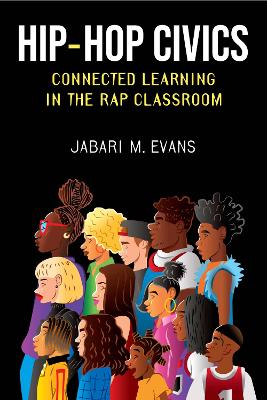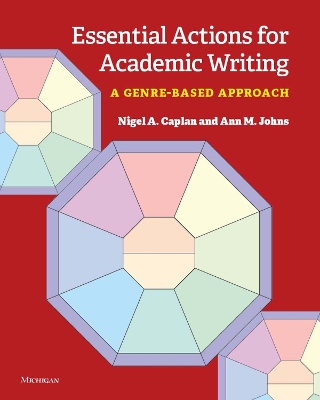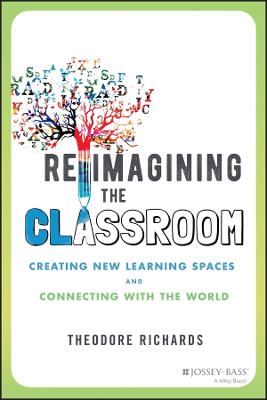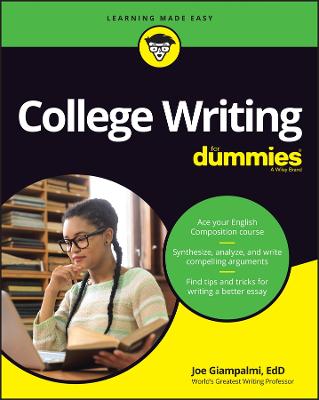Analysis and Argument in First-Year Writing and Beyond
 -15%
portes grátis
-15%
portes grátis
Analysis and Argument in First-Year Writing and Beyond
A Functional Perspective
Mitchell, Thomas D.; Gomez-Laich, Dr. Maria Pia; Pessoa, Silvia
The University of Michigan Press
10/2024
166
Mole
9780472039777
15 a 20 dias
Descrição não disponível.
Table of Contents
Preface
Chapter 1. Theoretical Principles for Scaffolding Argumentative Writing
1. Systemic Functional Linguistics and Genre
2. The 3x3 Toolkit for conceptualizing argumentative writing
3. Understanding the 3x3 through analysis of history arguments: The importance of interpersonal meanings
4. The 3x3 for diagnosing challenges with argumentation: Challenges with interpersonal meanings
5. Applying the 3x3 to unpack the process of analysis: The importance of ideational meanings
6. Applying the 3x3 to scaffolding first-year writing
7. How to use the 3x3 for scaffolding argumentative writing
8. The Teaching and Learning Cycle
Chapter 2. The Onion Model: A resource to help students to move from knowledge display to knowledge transformation
1. What's the expectation and what is the challenge for students?
2. What does the challenge look like in first-year writing and in writing in the disciplines?
3. What resource can we use to address the problem?
4. Lessons
5. Concluding remarks
Chapter 3: Writing effective claims: Key words, evaluations, and causal relations
1. What's the expectation and what is the challenge for students?
2. What does the challenge look like in first-year writing and in writing in the disciplines?
3. What tools can we use to address the problem?
4. Lessons
5. Concluding remarks
Chapter 4. I Know, I See, I Conclude: Resources to help students adopt effective patterns of analytical writing
1. What is the expectation and what is the challenge?
2. What does the challenge look like in first-year writing and in writing in the disciplines?
3. How can we help students with this challenge?
4. Lessons
5. Concluding remarks
Chapter 5. ENGAGEMENT: Resources to help students align the reader toward the writer's perspective
1. What is the expectation and what is the challenge?
2. What does the challenge look like in first-year writing and in writing in the disciplines?
3. How can we help students with this challenge?
4. Lessons
5. Concluding remarks
Chapter 6. Justification: Resources for justifying a position among alternatives
1. What's the expectation and what is the challenge for students?
2. What does the challenge look like in first-year writing and in writing in the disciplines?
3. What resources can we use to address the challenge?
4. Lessons
5. Concluding remarks
Chapter 7. Tips for assigning and assessing argumentative writing
1. Overview
2. The importance of designing assignment guidelines and prompts that align with pedagogical expectations
3. The importance of word choice in prompts and guidelines
4. The importance of avoiding question sets that are meant to be considered holistically
5. The importance of having consistent parts in (first-year writing) assignment guidelines
6. Making language expectations explicit in assessment rubrics
7. Applying the Teaching Learning Cycle: Drafting, feedback, and negotiated construction
8. Concluding remarks
Preface
Chapter 1. Theoretical Principles for Scaffolding Argumentative Writing
1. Systemic Functional Linguistics and Genre
2. The 3x3 Toolkit for conceptualizing argumentative writing
3. Understanding the 3x3 through analysis of history arguments: The importance of interpersonal meanings
4. The 3x3 for diagnosing challenges with argumentation: Challenges with interpersonal meanings
5. Applying the 3x3 to unpack the process of analysis: The importance of ideational meanings
6. Applying the 3x3 to scaffolding first-year writing
7. How to use the 3x3 for scaffolding argumentative writing
8. The Teaching and Learning Cycle
Chapter 2. The Onion Model: A resource to help students to move from knowledge display to knowledge transformation
1. What's the expectation and what is the challenge for students?
2. What does the challenge look like in first-year writing and in writing in the disciplines?
3. What resource can we use to address the problem?
4. Lessons
5. Concluding remarks
Chapter 3: Writing effective claims: Key words, evaluations, and causal relations
1. What's the expectation and what is the challenge for students?
2. What does the challenge look like in first-year writing and in writing in the disciplines?
3. What tools can we use to address the problem?
4. Lessons
5. Concluding remarks
Chapter 4. I Know, I See, I Conclude: Resources to help students adopt effective patterns of analytical writing
1. What is the expectation and what is the challenge?
2. What does the challenge look like in first-year writing and in writing in the disciplines?
3. How can we help students with this challenge?
4. Lessons
5. Concluding remarks
Chapter 5. ENGAGEMENT: Resources to help students align the reader toward the writer's perspective
1. What is the expectation and what is the challenge?
2. What does the challenge look like in first-year writing and in writing in the disciplines?
3. How can we help students with this challenge?
4. Lessons
5. Concluding remarks
Chapter 6. Justification: Resources for justifying a position among alternatives
1. What's the expectation and what is the challenge for students?
2. What does the challenge look like in first-year writing and in writing in the disciplines?
3. What resources can we use to address the challenge?
4. Lessons
5. Concluding remarks
Chapter 7. Tips for assigning and assessing argumentative writing
1. Overview
2. The importance of designing assignment guidelines and prompts that align with pedagogical expectations
3. The importance of word choice in prompts and guidelines
4. The importance of avoiding question sets that are meant to be considered holistically
5. The importance of having consistent parts in (first-year writing) assignment guidelines
6. Making language expectations explicit in assessment rubrics
7. Applying the Teaching Learning Cycle: Drafting, feedback, and negotiated construction
8. Concluding remarks
Este título pertence ao(s) assunto(s) indicados(s). Para ver outros títulos clique no assunto desejado.
Analytical writing;argumentative writing;disciplinary writing;systemic functional linguistics;genre;genre-pedagogy;3x3 toolkit;first-year writing;academic writing;writing across the disciplines;interdisciplinary collaboration;argument;analysis;assessment;rubrics;writing assignments;assignment design;engagement;stance;claims;options and alternatives;explicit instruction
Table of Contents
Preface
Chapter 1. Theoretical Principles for Scaffolding Argumentative Writing
1. Systemic Functional Linguistics and Genre
2. The 3x3 Toolkit for conceptualizing argumentative writing
3. Understanding the 3x3 through analysis of history arguments: The importance of interpersonal meanings
4. The 3x3 for diagnosing challenges with argumentation: Challenges with interpersonal meanings
5. Applying the 3x3 to unpack the process of analysis: The importance of ideational meanings
6. Applying the 3x3 to scaffolding first-year writing
7. How to use the 3x3 for scaffolding argumentative writing
8. The Teaching and Learning Cycle
Chapter 2. The Onion Model: A resource to help students to move from knowledge display to knowledge transformation
1. What's the expectation and what is the challenge for students?
2. What does the challenge look like in first-year writing and in writing in the disciplines?
3. What resource can we use to address the problem?
4. Lessons
5. Concluding remarks
Chapter 3: Writing effective claims: Key words, evaluations, and causal relations
1. What's the expectation and what is the challenge for students?
2. What does the challenge look like in first-year writing and in writing in the disciplines?
3. What tools can we use to address the problem?
4. Lessons
5. Concluding remarks
Chapter 4. I Know, I See, I Conclude: Resources to help students adopt effective patterns of analytical writing
1. What is the expectation and what is the challenge?
2. What does the challenge look like in first-year writing and in writing in the disciplines?
3. How can we help students with this challenge?
4. Lessons
5. Concluding remarks
Chapter 5. ENGAGEMENT: Resources to help students align the reader toward the writer's perspective
1. What is the expectation and what is the challenge?
2. What does the challenge look like in first-year writing and in writing in the disciplines?
3. How can we help students with this challenge?
4. Lessons
5. Concluding remarks
Chapter 6. Justification: Resources for justifying a position among alternatives
1. What's the expectation and what is the challenge for students?
2. What does the challenge look like in first-year writing and in writing in the disciplines?
3. What resources can we use to address the challenge?
4. Lessons
5. Concluding remarks
Chapter 7. Tips for assigning and assessing argumentative writing
1. Overview
2. The importance of designing assignment guidelines and prompts that align with pedagogical expectations
3. The importance of word choice in prompts and guidelines
4. The importance of avoiding question sets that are meant to be considered holistically
5. The importance of having consistent parts in (first-year writing) assignment guidelines
6. Making language expectations explicit in assessment rubrics
7. Applying the Teaching Learning Cycle: Drafting, feedback, and negotiated construction
8. Concluding remarks
Preface
Chapter 1. Theoretical Principles for Scaffolding Argumentative Writing
1. Systemic Functional Linguistics and Genre
2. The 3x3 Toolkit for conceptualizing argumentative writing
3. Understanding the 3x3 through analysis of history arguments: The importance of interpersonal meanings
4. The 3x3 for diagnosing challenges with argumentation: Challenges with interpersonal meanings
5. Applying the 3x3 to unpack the process of analysis: The importance of ideational meanings
6. Applying the 3x3 to scaffolding first-year writing
7. How to use the 3x3 for scaffolding argumentative writing
8. The Teaching and Learning Cycle
Chapter 2. The Onion Model: A resource to help students to move from knowledge display to knowledge transformation
1. What's the expectation and what is the challenge for students?
2. What does the challenge look like in first-year writing and in writing in the disciplines?
3. What resource can we use to address the problem?
4. Lessons
5. Concluding remarks
Chapter 3: Writing effective claims: Key words, evaluations, and causal relations
1. What's the expectation and what is the challenge for students?
2. What does the challenge look like in first-year writing and in writing in the disciplines?
3. What tools can we use to address the problem?
4. Lessons
5. Concluding remarks
Chapter 4. I Know, I See, I Conclude: Resources to help students adopt effective patterns of analytical writing
1. What is the expectation and what is the challenge?
2. What does the challenge look like in first-year writing and in writing in the disciplines?
3. How can we help students with this challenge?
4. Lessons
5. Concluding remarks
Chapter 5. ENGAGEMENT: Resources to help students align the reader toward the writer's perspective
1. What is the expectation and what is the challenge?
2. What does the challenge look like in first-year writing and in writing in the disciplines?
3. How can we help students with this challenge?
4. Lessons
5. Concluding remarks
Chapter 6. Justification: Resources for justifying a position among alternatives
1. What's the expectation and what is the challenge for students?
2. What does the challenge look like in first-year writing and in writing in the disciplines?
3. What resources can we use to address the challenge?
4. Lessons
5. Concluding remarks
Chapter 7. Tips for assigning and assessing argumentative writing
1. Overview
2. The importance of designing assignment guidelines and prompts that align with pedagogical expectations
3. The importance of word choice in prompts and guidelines
4. The importance of avoiding question sets that are meant to be considered holistically
5. The importance of having consistent parts in (first-year writing) assignment guidelines
6. Making language expectations explicit in assessment rubrics
7. Applying the Teaching Learning Cycle: Drafting, feedback, and negotiated construction
8. Concluding remarks
Este título pertence ao(s) assunto(s) indicados(s). Para ver outros títulos clique no assunto desejado.
Analytical writing;argumentative writing;disciplinary writing;systemic functional linguistics;genre;genre-pedagogy;3x3 toolkit;first-year writing;academic writing;writing across the disciplines;interdisciplinary collaboration;argument;analysis;assessment;rubrics;writing assignments;assignment design;engagement;stance;claims;options and alternatives;explicit instruction







